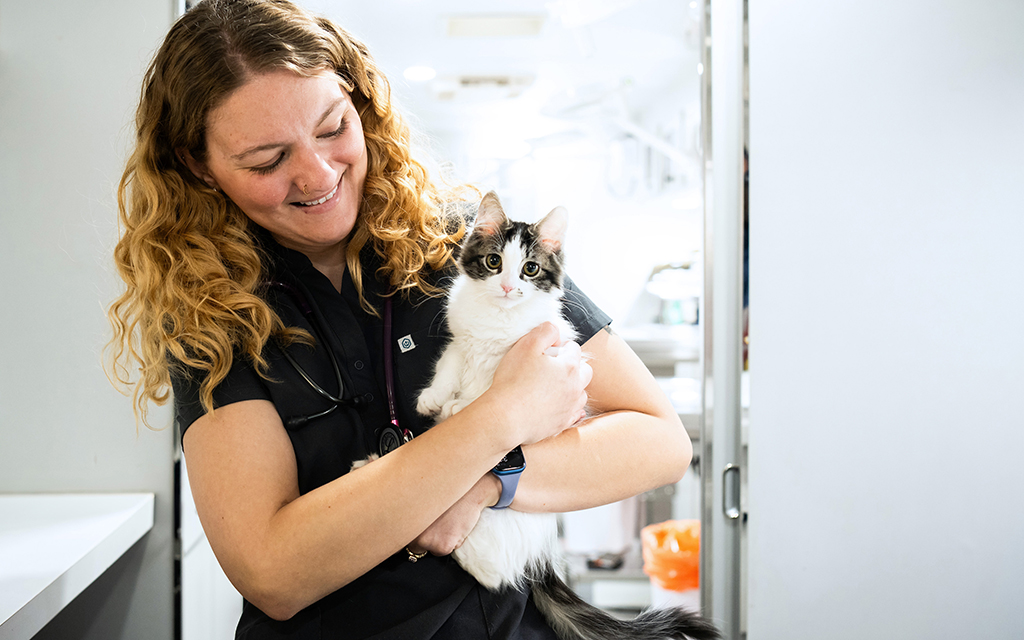As a fourth-year Mississippi State Doctor of Veterinary Medicine student, Camryn Carlson has completed more than 100 solo surgeries.
That number will continue to grow during her time in the university’s Shelter Medicine Program. This mandatory rotation accounts for the majority of DVM students’ surgical experience, as they complete an average of 55 spay and neuter surgeries for rescues and shelters statewide during the two weeks.
Even though the students’ rotation is short, the program itself runs year-round, accommodating the state’s high demand for spay and neuter services. Some students, like Carlson, opt for additional rotations with the program.
Carlson said she was nervous the first few days as she completed a series of spay and neuter surgeries, but her nerves calmed with each procedure.
“It’s scary at first, but within a week I built my confidence,” the Cordova, Tennessee, native said. “The way they teach and coach you, you really catch on quickly.”

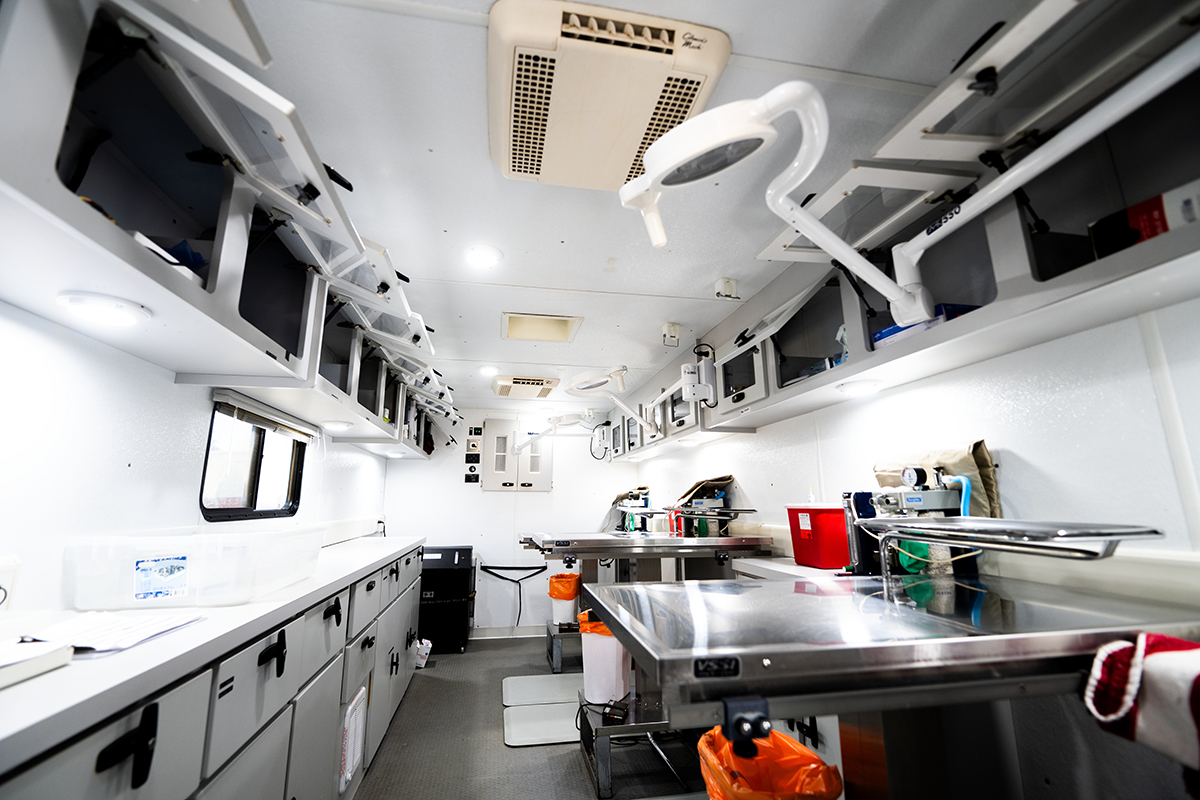
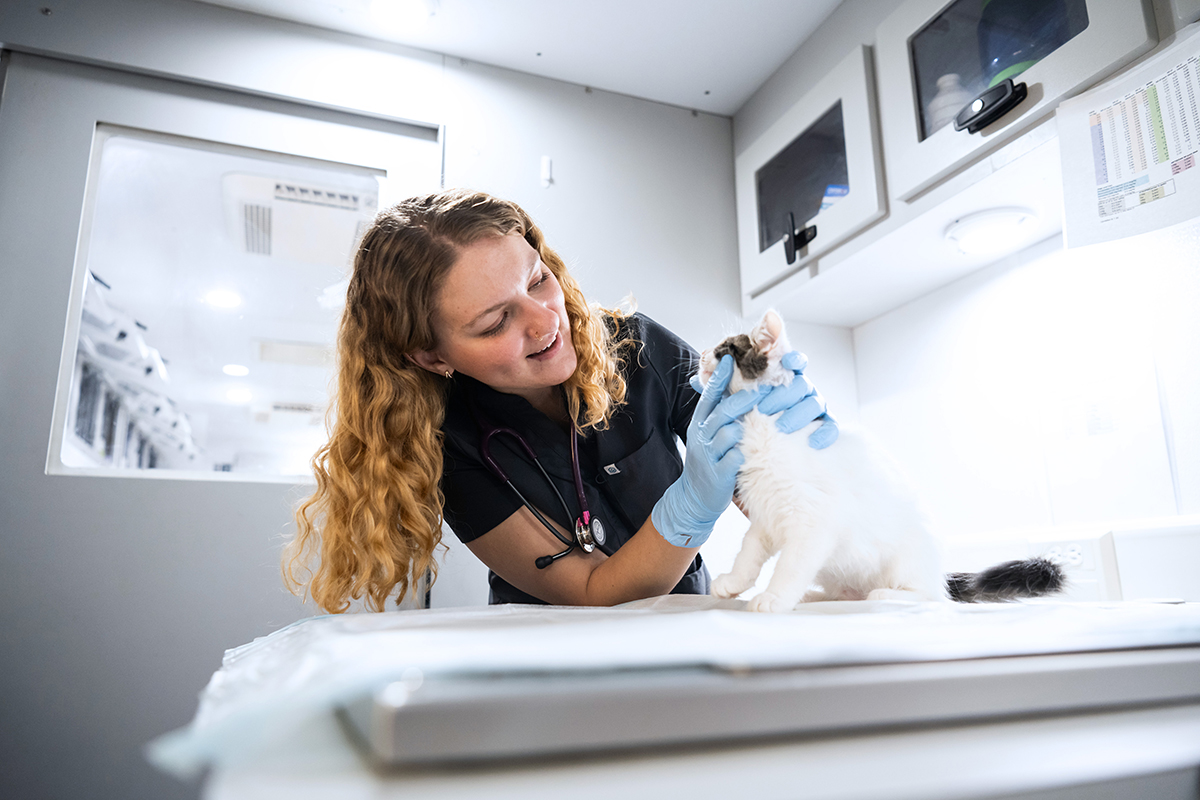
MSU veterinary student Camryn Carlson performs a gentle exam on a kitten, showcasing the hands-on training and compassionate care at the heart of the Shelter Medicine Program.
Dr. Jake Shivley, Shelter Medicine service chief, spearheads the program, overseeing medical services for the animals while mentoring future veterinarians through hands-on surgical experience. The program operates efficiently, providing spays and neuters nine days out of every two weeks.
Shivley said the program has three missions: help with pet overpopulation, increase likelihood of adoption and provide hands-on surgical experience to future veterinarians.
“Our students are exposed to the problems those animals are experiencing,” he said. “They see the overwhelming effects of pet overpopulations, especially in our state. They also see the struggles that animal shelters have to get those pets adopted.”
Shivley, an MSU DVM graduate, works hand-in-hand with program founder Dr. Phil Bushby to provide students with high-quality education and lift financial burdens from animal shelters. During the program’s early years, Shivley—then Bushby’s student—completed his first surgery under his mentor’s guidance.
“When I was a student, I only performed two days of surgery,” Shivley said. “It was a phenomenal experience. The program has grown immensely, and it’s an honor to carry on Dr. Bushby’s legacy. Looking back, it was incredible. Seeing how much our students achieve now: It’s mind-blowing and a cool thing to be a part of.”
How It Began
Bushby, who holds the Marcia Lane Endowed Chair in Humane Ethics and Animal Welfare as a semi-retired MSU veterinarian, founded the renowned MSU Shelter Medicine Program in the 1990s. He was inspired by a career-defining internship at the Henry Berg Memorial Hospital of the American Society for the Prevention of Cruelty to Animals in New York. There, more than 50 years ago, he witnessed the harsh realities of pet overpopulation, massive euthanasia and the urgent need for widespread spay and neuter initiatives.
At the time, the ASPCA hospital cared for animals from all five New York City boroughs, taking in hundreds of animals a day. It was unmanageable, Bushby recalled. If anything was wrong with a dog or cat—from being heartworm positive to simple tarter build up on teeth—the veterinarians were instructed to place it on a list to be euthanized.
“It sounds cold and heartless, but there’s no animal-care facility that could take that number of intakes,” he said. “I can remember the day we scheduled 50 animals in a row for euthanasia. In the year of my internship, they euthanized more than 130,000 stray dogs and cats. That statistic was always there in my mind. That haunts you, but that’s also how this all started.”
After arriving in Starkville in 1978, Bushby dedicated his career to educating MSU veterinary students about pet overpopulation and urging the future veterinarians to advocate for shelter animals.
In the 1990s, DVM student Sandy Kerr Thomas, who volunteered with the Columbus-Lowndes Humane Society, urged Bushby to help the shelter with over–crowding. This question, combined with Bushby’s advocacy for shelter animals, brought life to the expansive and impactful DVM Shelter Medicine Program.
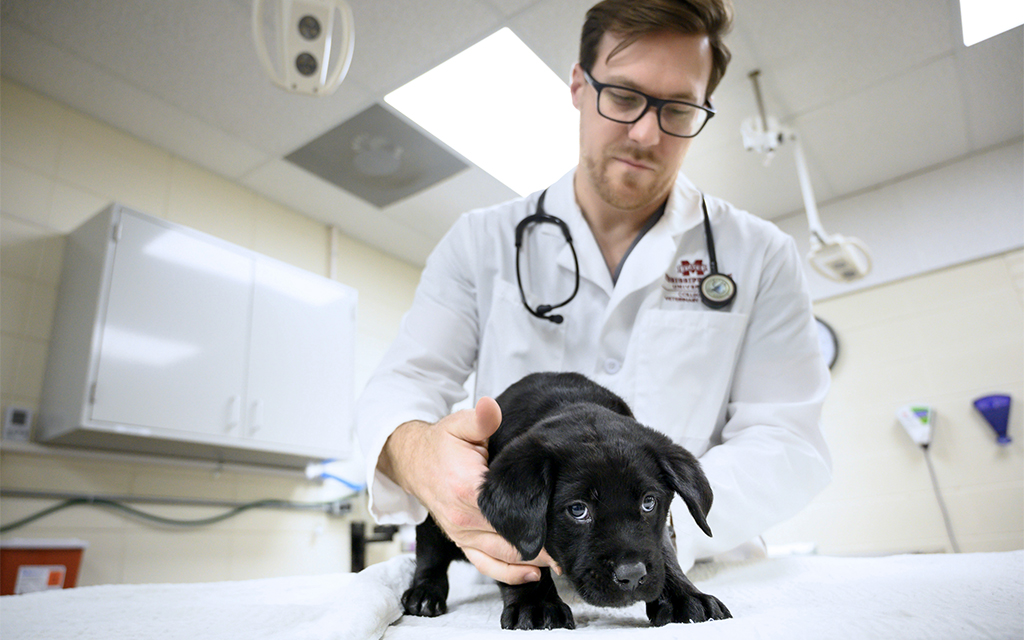
Shelter Med Expansion
The program was able to expand and start making a statewide impact in 2006. Through a series of gifts and grants, the university purchased two Mobile Veterinary Clinics to enable Bulldog vets and students to travel the state performing spay and neuter procedures at no cost to shelters and rescues. For the next 13 years, DVM students performed those surgeries in various locations until the COVID-19 pandemic parked the mobile clinics permanently.
This change stationed the Shelter Medicine Program in Starkville, which helped it grow and operate more efficiently from its homebase on the MSU campus.
Now, shelters and rescues travel to Starkville, where DVM students perform those surgeries—still at no cost, thanks to financial support from generous donors across the country—many of whom have never set foot on MSU’s campus but still choose to support the mission of Shelter Medicine because of its impact. Though the mobile units no longer travel, they are still used as surgical rooms for students to perfect their skills throughout these rotations.
MSU’s CVM tackles pet overpopulation in layers—first by partnering with nearly 30 shelters and rescues statewide to provide free spay and neuters, then by graduating veterinary students who understand shelter dynamics and the importance of spays and neuters and graduating veterinarians with unparalleled surgical experience, confidence and competence.
Although Bushby retired from the university in 2014, he still works part-time alongside his former students, who are now shelter medicine faculty, as they continue to mentor and shadow students through surgeries, hoping to grow the university’s impact on shelter animals year after year.
“We do about 8,000 surgeries a year for free,” Shivley said. “We’re providing a service to our community, our shelters and our rescues.”
Current students complete up to 10 surgeries a day—spaying and neutering dogs, cats and even the occasional rabbit—something Shivley says is a rare feat for most veterinary students nationwide.
“We like to graduate veterinarians who know how to do surgeries, I know this sounds crazy but there are vet students all across the country only doing half a spay or maybe just one before they graduate,” he said. “For the two weeks our students in the Shelter Medicine Program—which is just a small part of their overall education—they average about 55 surgeries or more. It’s a machine we have perfected and it’s well-oiled.”
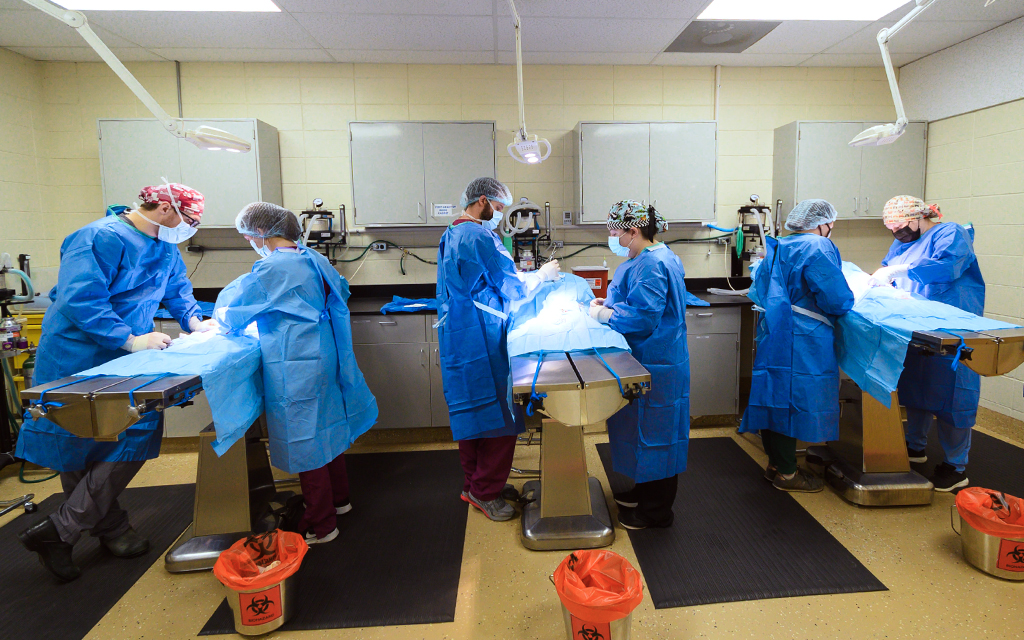
MSU vs. Everybody
For MSU students, having this level of surgical experience seems normal; however, that’s not the case. It wasn’t until Carlson traveled out of state for an externship that she realized the quality and level of expertise she gained from her studies.
“It really reinforces how amazing this experience is. I almost feel like I have a higher comfort level than some practicing doctors I’ve worked with outside of MSU because of the way they’re teaching it here,” she said. “It’s rare. I don’t know of any other school that gives you this type of experience, and I think that’s solely because of the Shelter Medicine Program.”
Shivley and the CVM team create a professional atmosphere where students learn to navigate stressful situations and produce positive outcomes.
“It’s a really good environment. Vet school is a very high-stress place, and Shelter Medicine is a change of pace,” Carlson said. “They are very friendly and very professional. It’s a safe environment to build your confidence. We are recognized as future doctors, and it’s a respectful group of people. You get more comfortable with the skills you’ve been working on the past few years. It’s a very low-stress environment in something that can obviously be very stressful.”
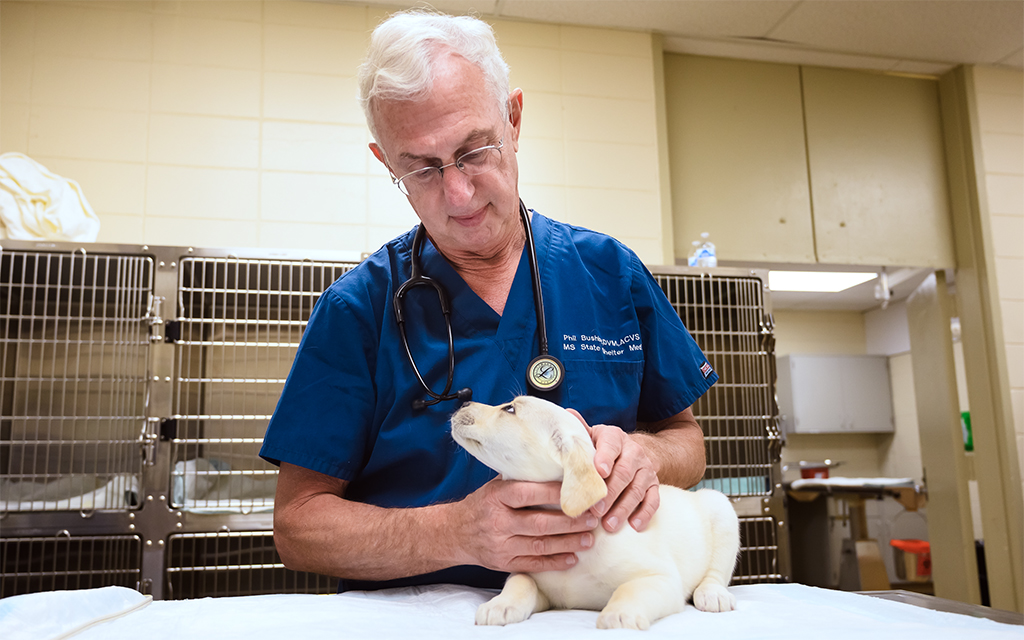
The Impact
While the statistics tell a compelling story, Bushby knows the impact is much larger than those numbers dictate. Since Shelter Medicine’s inception, DVM students have performed more than 126,000 spays and neuters—significantly increasing those animals’ chances of finding permanent homes and reducing pet-overpopulation by astronomical numbers.
Just one spayed or neutered cat can prevent more than 2 million offspring over the course of eight years. By performing these surgeries, the projected pet population decreases, and spayed or neutered animals are 80% more likely to be adopted.
“The numbers of animals impacted and surgical hours gained by students are significant, but just as important is something immeasurable—the experience and confidence we give our students before they receive their degrees,” Bushby said. “We graduate students who understand, who have been in shelters and worked in shelters, and who go into their communities and understand the issues they face. How many surgeries have they done since they graduate? That’s the real number.
“The impact is not just in the 30 shelters we work with, it’s more,” he continued. “It’s what’s happening in the shelters and rescues our graduates the past 30 years are working with. We don’t know that number and we never will.”
By Mary Pollitz, Photos by Grace Cockrell and Tom Thompson
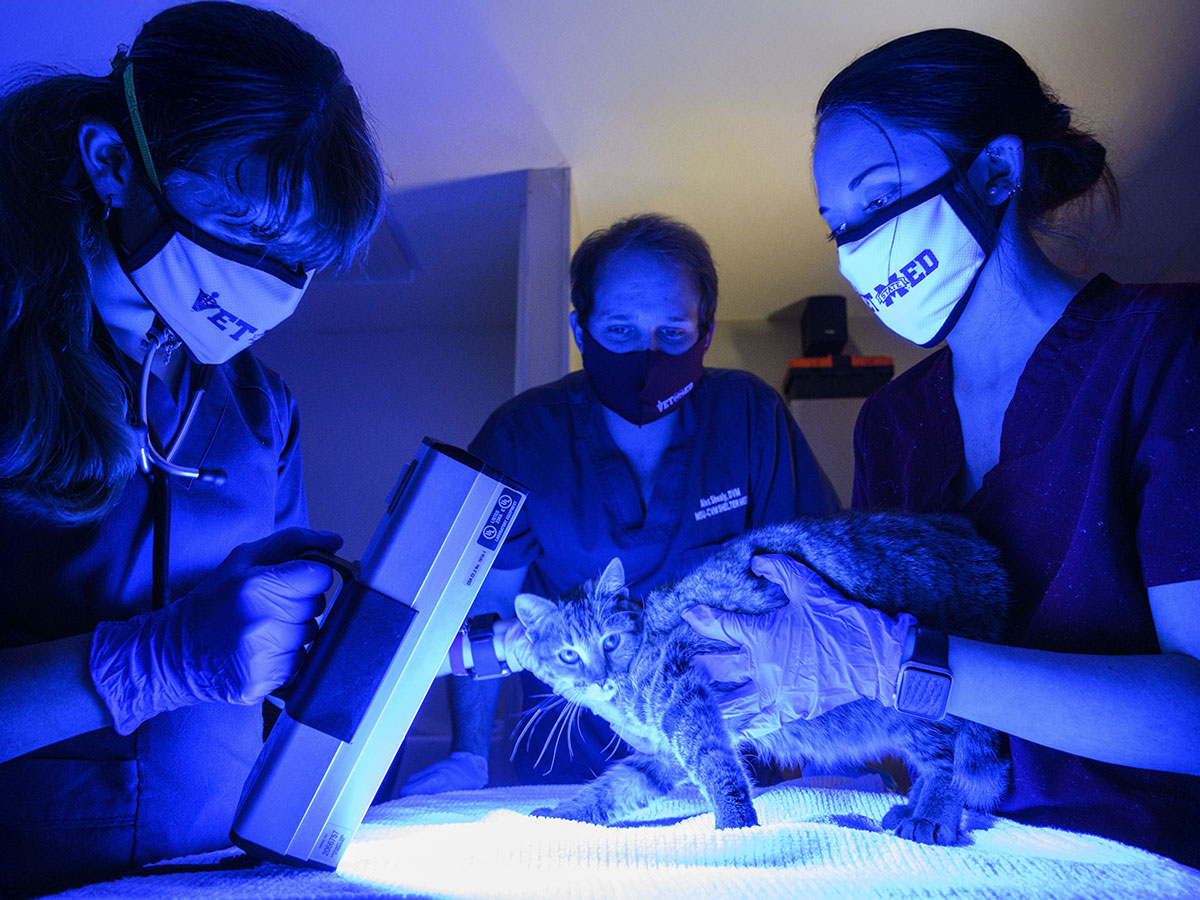
College of Veterinary Medicine Partners with Local Humane Society
Another facet of the Mississippi State University’s Shelter Medicine Program is the on-going five-year partnership with the Oktibbeha County Humane Society, which enhances students’ educational opportunities while providing targeted assistance to the local shelter.
Dr. Jake Shivley, MSU’s Shelter Medicine service chief, also oversees this partnership and ensures students provide shelter animals with the utmost care. By having a portion of their education take place in an actual shelter, these students are exposed to the issues plaguing the community while providing necessary medical care.
“Students are placed in a real-world, authentic learning environment where they are part of providing much-needed services to OCHS and the community,” he said. “They are also getting real-world medical and surgical experience in the process. This type of service-learning is highly impactful for their learning now and for their future careers.”
OCHS Executive Director Michele Anderson understands the value of these doctors-in-training interacting with the shelter’s animals and staff. Through this partnership, the CVM provides 16 hours of medical assistance and two days of surgical care to the shelter each week.
“It benefits students through hands-on learning experiences, supports the shelter with essential veterinary care and raises important awareness about animal welfare issues,” Anderson said. “Veterinary students, under the supervision of CVM faculty, perform health exams, administer vaccines and preventatives, and help provide care for injured and sick shelter animals.”
In addition to being the brainchild behind the Shelter Medicine Program, Dr. Phil Bushby—a semi-retired MSU veterinarian and professor—also started the partnership with OCHS to ensure local animals’ needs were being met.
“Dr. Bushby has been instrumental in the establishment and success of this partnership,” Anderson said. “His leadership and dedication have helped shape this vital program.”
MSU’s partnership with OCHS operates through the support of donors, and this year’s operations were funded through a gift from MSU alumna Dr. Rebecca Burcham. The university’s partnership with the humane society will continue to operate with the help of donors who support the CVM and its mission.
“Dr. Burcham’s generous gift was crucial in ensuring the continuation of the partnership and that these vital services remain available, benefiting countless animals and the broader community,” Anderson said.


